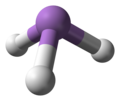Arsine
 |
|||
|
|
|||
| Names | |||
|---|---|---|---|
|
IUPAC names
Arsenic trihydride
Arsane Trihydridoarsenic |
|||
| Other names
Arseniuretted hydrogen,
Arsenous hydride, hydrogen arsenide Arsenic hydride |
|||
| Identifiers | |||
|
7784-42-1 |
|||
| 3D model (Jmol) | Interactive image | ||
| ChEBI |
CHEBI:47217 |
||
| ChemSpider |
22408 |
||
| ECHA InfoCard | 100.029.151 | ||
| EC Number | 232-066-3 | ||
| 599 | |||
| PubChem | 23969 | ||
|
|||
|
|||
| Properties | |||
| AsH3 | |||
| Molar mass | 77.9454 g/mol | ||
| Appearance | colourless gas | ||
| Density | 4.93 g/l, gas; 1.640 g/mL (−64 °C) | ||
| Melting point | −111.2 °C (−168.2 °F; 162.0 K) | ||
| Boiling point | −62.5 °C (−80.5 °F; 210.7 K) | ||
| 0.07 g/100 ml (25 °C) | |||
| Vapor pressure | 14.9 atm | ||
| Structure | |||
| trigonal pyramidal | |||
| 0.20 D | |||
| Thermochemistry | |||
|
Std molar
entropy (S |
223 J.K−1.mol−1 | ||
|
Std enthalpy of
formation (ΔfH |
+66.4 kJ/mol | ||
| Hazards | |||
| Main hazards | explosive, flammable, potential occupational carcinogen | ||
| Safety data sheet | See: data page | ||
|
EU classification (DSD)
|
Very flammable (F+) Highly toxic (T+) Harmful (Xn) Dangerous for the environment (N) |
||
| R-phrases | R12, R26, R48/20, R50/53 | ||
| S-phrases | (S1/2), S9, S16, S28, S33, S36/37, S45, S60, S61 | ||
| NFPA 704 | |||
| Flash point | −62 °C (−80 °F; 211 K) | ||
| Explosive limits | 5.1%-78% | ||
| Lethal dose or concentration (LD, LC): | |||
|
LD50 (median dose)
|
2.5mg/kg(Intravenous) | ||
|
LC50 (median concentration)
|
120 ppm (rat, 10 min) 77 ppm (mouse, 10 min) 201 ppm (rabbit, 10 min) 108 ppm (dog, 10 min) |
||
|
LCLo (lowest published)
|
250 ppm (human, 30 min) 300 ppm (human, 5 min) 25 ppm (human, 30 min) |
||
| US health exposure limits (NIOSH): | |||
|
PEL (Permissible)
|
TWA 0.05 ppm (0.2 mg/m3) | ||
|
REL (Recommended)
|
C 0.002 mg/m3 [15-minute] | ||
|
IDLH (Immediate danger)
|
3 ppm | ||
| Related compounds | |||
|
Related hydrides
|
Ammonia; Phosphine; Stibine; Bismuthine | ||
| Supplementary data page | |||
|
Refractive index (n), Dielectric constant (εr), etc. |
|||
|
Thermodynamic
data |
Phase behaviour solid–liquid–gas |
||
| UV, IR, NMR, MS | |||
|
Except where otherwise noted, data are given for materials in their standard state (at 25 °C [77 °F], 100 kPa).
|
|||
|
|
|||
| Infobox references | |||
Arsine is an inorganic compound with the formula AsH3. This flammable, pyrophoric, and highly toxic pnictogen hydride gas is one of the simplest compounds of arsenic. Despite its lethality, it finds some applications in the semiconductor industry and for the synthesis of organoarsenic compounds. The term arsine is commonly used to describe a class of organoarsenic compounds of the formula AsH3−xRx, where R = aryl or alkyl. For example, As(C6H5)3, called triphenylarsine, is referred to as "an arsine."
At its standard state, arsine is a colorless, denser-than-air gas that is slightly soluble in water (20% at 20 C) and in many organic solvents as well. Whereas arsine itself is odorless, owing to its oxidation by air it is possible to smell a slight garlic or fish-like scent when the compound is present above 0.5 ppm. This compound is generally regarded as stable, since at room temperature it decomposes only slowly. At temperatures of ca. 230 °C decomposition to arsenic and hydrogen is rapid. Several factors, such as humidity, presence of light and certain catalysts (namely aluminium) facilitate the rate of decomposition.
AsH3 is a pyramidal molecule with H–As–H angles of 91.8° and three equivalent As–H bonds, each of 1.519 Å length.
AsH3 is generally prepared by the reaction of As3+ sources with H− equivalents.
...
Wikipedia



